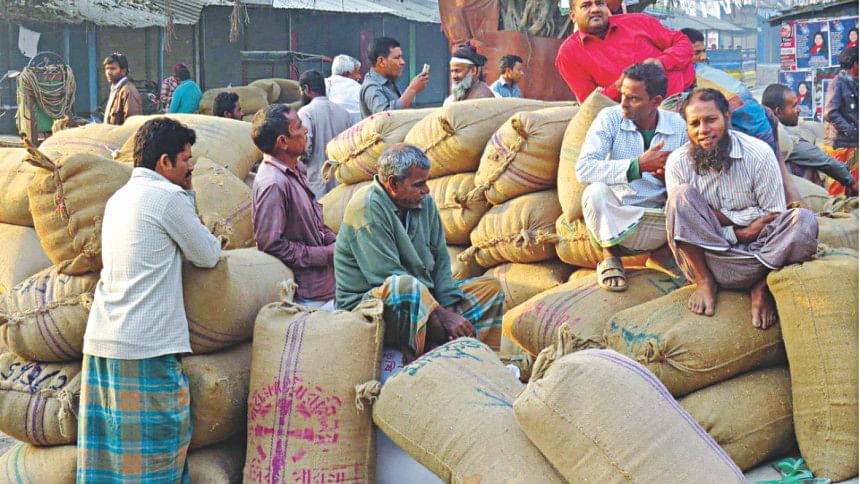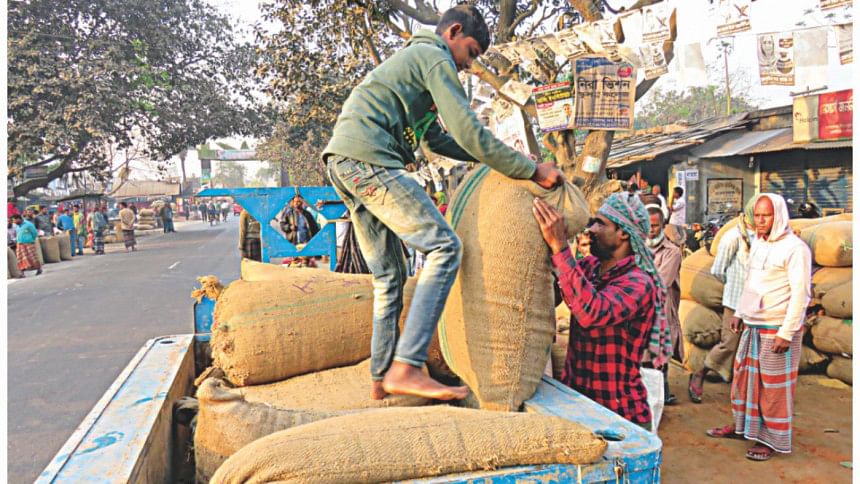Price fall hits Aman farmers in Dinajpur

Recently, Sisnabi Mondol, a farmer in Dinajpur's Chirirbandar upazila, has sold his Aman paddy at Tk 600 per maund, whereas the rate was Tk 720 when the harvest season began in December.
Within just three months, the price of the coarse rice has fallen by Tk 100 per maund, much to the frustration of farmers.
This has put Sisnabi and other farmers in the region in trouble.
Now, the farmers are in fear that paddy prices might fall further if no steps were taken before the start of boro harvesting expected to begin late this month.
“As no other varieties of rice are being harvested and the Boro cultivation is going on, Aman prices should not have fallen this way,” said the man from Surueel village.
“We usually keep the harvests stored until March to get a decent price and to meet up the production cost for Boro cultivation,” he said, and added, “But now, farmers are incurring huge losses as their production cost was no less than Tk 700 per maund.”
The price of Aman paddy started falling at the end of January, according to farmers in the upazila.
Market insiders have identified two causes for this: an “unplanned” import of rice in fiscal 2017-18 and a bumper yield of Aman this season.
Although the latter one appears to be a blessing, farmers are actually paying the price, said KM Layek Ali, general secretary of Bangladesh Auto Major and Husking Mill Owners' Association.
“The imported rice is still dominating the market. Because of these, Aman prices have fallen,” he said.
“This season [October to December], the country saw a production of 1.53 crore metric tonnes of Aman rice, which was 13 lakh metric tonnes higher than the target,” said Abdul Muyeed, director at the field service unit of Department of Agricultural Extension (DAE).
In fiscal 2017-18, the total rice production in the country was 3.63 crore metric tonnes, according to DAE. As much as 3.52 crore metric tonnes of rice was consumed in the period, the US Department of Agriculture mentioned in its Global Agriculture Information Network report 2019.

According to the food ministry, in the previous and current fiscal year, 39 lakh metric tonne and 1.5 lakh metric tonnes of rice were imported respectively.
Until March last year, there were 13.67 lakh metric tonnes of rice in the government's warehouse. The amount was sufficient and no sign of food crisis surfaced.
During a recent visit to Gopalganj paddy market in Dinajpur sadar upazila, the district correspondent saw farmers waiting for buyers with sacks of paddy lying by the roads. But they hardly got any that day.
One of them, Mobarak Ali of Borail village, said he had 20 sacks of paddy but had no buyer.
“If I sell paddy at the current market rate which is Tk 600, I will lose Tk 100 per maund. Moreover, we need to pay Tk 100 to each carrier and Tk 20 for one sack. One sack means two maunds of paddy,” he said.
Reza Humayun Kabir Chowdhury Shamim, president of Dinajpur Rice Mills Owners Association, said, “Not only the farmers, we, the parties who bought paddy following Aman harvest, are also affected by the fall in price,” said .
“We are now incurring a loss of about Tk 200 per sack.”
Layek Ali said, “Once the boro paddy hits the market, the price of Aman paddy would drop further.”
He urged the government to consider limiting export of fine rice as a preventive measure.
Although the farmers are hit by losses, there is no sign of price falling at the retail rice markets in Dhaka. According to the food ministry, the current retail price for coarse rice in the capital is Tk 32/34 per kilogram.
(Dinajpur Correspondent Kongkon Karmaker contributed to this report)

 For all latest news, follow The Daily Star's Google News channel.
For all latest news, follow The Daily Star's Google News channel. 








Comments